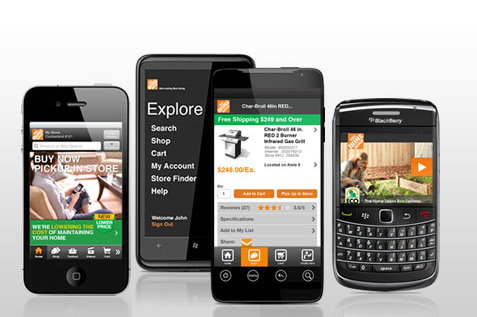 Google published a case study about The Home Depot, showing that mCommerce can work with the right strategy. It is always good to get inspired by what others are doing right, so we wanted to share this with our readers.
Google published a case study about The Home Depot, showing that mCommerce can work with the right strategy. It is always good to get inspired by what others are doing right, so we wanted to share this with our readers.
Today, The Home Depot is the world’s largest home improvement specialty retailer with more than 2,200 retail stores worldwide. As an early innovator in the mobile space, it saw the need to capitalize on the fast-growing mobile market opportunity.
The Home Depot’s first mobile site was launched in May 2010 and has continually improved over the last two years. With smartphone penetration in the U.S. now exceeding 50%, Matt Jones, General Manager of Mobile for Homedepot.com, says, “We are seeing a rapid escalation in the number of visits, in the types of usage, and in the customer’s desire to interact with our mobile content.”
To stay ahead of the curve, the company recently launched a significant mobile redesign, adding a new set of mobile functionalities based on user localization. When first accessing the mobile site, users are prompted to share their location, which allows them to access real-time store inventory, real-time pricing, and aisle-location for merchandise in any given Home Depot store.
Another very successful feature recently introduced is the ability to buy on mobile and pick-up in-store. The Home Depot’s new mobile site now features more than 1,000 video how-to’s, and despite being media-rich, the lightweight pages load quickly and are optimized for intuitive access on small screens that are gesture and touch-driven.
“We are seeing a rapid escalation in the number of visits, in the types of usage and in the customer’s desire to interact with our mobile content.” says Matthew Jones, general manager of mobile for The Home Depot.
Custom-built mobile site doubles traffic and conversions, quadruples mobile sales
The Home Depot’s mobile site success so far has been impressive: between 2011 and 2012, visits originating from a mobile phone have tripled.
This growth can be attributed to the company’s main audience:
•“Do-it-yourselfers,” hungry for content and convenience from wherever they are, and
•Pros/Contractors, who want to get in and out of the store quickly.
Overall, the user experience has improved markedly, with The Home Depot’s recent ranking rising from 15 to 7 on the Keynote Mobile Commerce Index (an index that shows the average response times, success rates, and download speeds for downloading the mobile pages of selected retailer sites). And the continuous mobile efforts have really paid off: “We doubled our mobile conversion rate and quadrupled our mobile commerce sales between the first half of this year and first half of last year,” says Jones.
Mobile-specific search advertising campaigns, using Google Mobile Ads, have been fundamental to The Home Depot’s online success. They include Mobile Ad formats such as call extensions for one-touch calling convenience, location extensions for access to addresses, and maps and mobile site links, so users can navigate straight to specific pages. The Home Depot is also making efforts on the display side focused on building awareness.
An app that maximizes smartphones’ potential
To expand their mobile audience, The Home Depot has also launched mobile applications for iPhone, Android, and Windows. The apps enable the company to explore native functionalities that only a mobile device can provide. For example, the company recently implemented augmented reality functionality— using the smartphone’s built-in camera, users can use the apps to overlay select merchandise images, such as patio sets or appliances, on the top of their current environment, like a sunroom or kitchen, and visualize how it would look.
The Home Depot’s apps are targeted at their most loyal customers, while the broader audience accesses the mobile site. According to Mr. Jones, this dual, synergistic mobile strategy is paying off in terms of incremental revenue and engagement with the brand.
“We doubled our mobile conversion rate and quadrupled our mobile commerce sales between the first half of this year and first half of last year,” Matthew Jones confirmed.
Mobile is the bridge between interconnected retail
As a multi-channel retailer, The Home Depot understands the impact of its mobile website on its physical stores: “There is a stronger connectivity between mobile and stores than there is between our desktop site and the stores. Mobile is the bridge between interconnected retail,” says Jones.
And understanding how mobile is adding value to the business requires factoring-in new mobile conversions: “Sales are the macro-conversion but when users lookup our store hours, or a store phone number or driving directions, those are other mobile conversions that will potentially lead to a physical in-store purchase,” Jones added.
The cost per macro-conversion has decreased by 75% since the mobile site launched, and the company is now closely monitoring other key mobile conversions. And this is just the beginning of the mobile journey: the company is perpetually looking for new innovations and continuous best-in-class performance. (Source: Google / www.mmaglobal.com)
By MediaBUZZ


